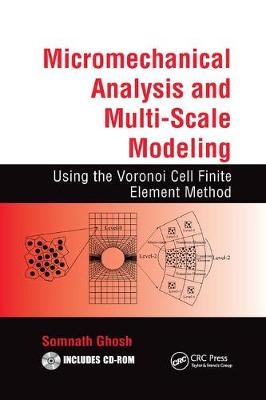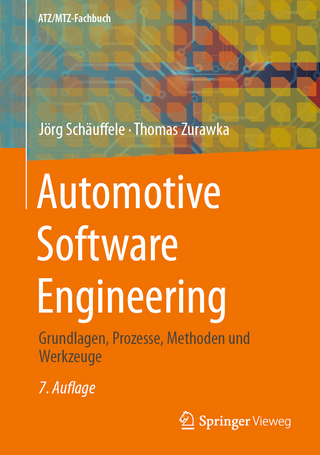
Micromechanical Analysis and Multi-Scale Modeling Using the Voronoi Cell Finite Element Method
CRC Press (Verlag)
978-1-138-37278-8 (ISBN)
- Titel ist leider vergriffen;
keine Neuauflage - Artikel merken
The focus is on micromechanical analysis using the Voronoi cell finite element method (VCFEM) developed by the author and his research group for the efficient and accurate modeling of materials with non-uniform heterogeneous microstructures. While the topics covered in the book encompass the macroscopic scale of structural components and the microscopic scale of constituent heterogeneities like inclusions or voids, the general framework may be extended to other scales as well.
The book presents the major components of the multi-scale analysis framework in three parts. Dealing with multi-scale image analysis and characterization, the first part of the book covers 2D and 3D image-based microstructure generation and tessellation into Voronoi cells. The second part develops VCFEM for micromechanical stress and failure analysis, as well as thermal analysis, of extended microstructural regions. It examines a range of problems solved by VCFEM, from heat transfer and stress-strain analysis of elastic, elastic-plastic, and viscoplastic material microstructures to microstructural damage models including interfacial debonding and ductile failure. Establishing the multi-scale framework for heterogeneous materials with and without damage, the third part of the book discusses adaptive concurrent multi-scale analysis incorporating bottom-up and top-down modeling.
Including numerical examples and a CD-ROM with VCFEM source codes and input/output files, this book is a valuable reference for researchers, engineers, and professionals involved with predicting the performance and failure of materials in structure-materials interactions.
Somnath Ghosh is the Michael G. Callas Professor in the Department of Civil Engineering and Professor of Mechanical Engineering at Johns Hopkins University. Prior to this, he was the John B. Nordholt Professor in the Department of Mechanical Engineering at the Ohio State University until March 2011. His research has been at the leading edge of multiple-scale modeling of mechanical behavior and failure response of heterogeneous material systems such as composites, polycrystalline metals and alloys, etc., for structure–material interaction. Specific areas of his contributions include multiple-scale modeling in spatial and temporal domains, failure modeling of composite materials and structures, reliability, fatigue and failure modeling of metals, composites and thermal barrier coatings, molecular dynamics simulations of thin films and nano-composites, metal forming and casting and process design. He was awarded the prestigious NSF Young Investigator award in 1994. He is a fellow of the American Society for Mechanical Engineers, ASM International, the National Materials Society, the American Academy of Mechanics, the International Association of Computational Mechanics, the U.S. Association of Computational Mechanics, and the American Association for the Advancement of Science.
Introduction
Image Extraction and Virtual Microstructure Simulation
Multi-Scale Simulation of High-Resolution Microstructures
Three-Dimensional Simulation of Microstructures with Dispersed Particulates
Summary
2D- and 3D-Mesh Generation by Voronoi Tessellation
Two-Dimensional Dirichlet Tessellations in Plane
Mesh Generator Algorithm
Numerical Examples
Voronoi Tessellation for Three-Dimensional Mesh Generation
Summary
Microstructure Characterization and Morphology-Based Domain Partitioning
Characterization of Computer-Generated Microstructures
Quantitative Characterization of Real 3D Microstructures
Domain Partitioning: A Pre-Processor for Multi-Scale Modeling
Summary
The Voronoi Cell Finite Element Method (VCFEM) for 2D Elastic Problems
Introduction
Energy Minimization Principles in VCFEM Formulation
Element Interpolations and Assumptions
Weak Forms in the VCFEM Variational Formulation
Solution Methodology and Numerical Aspects in VCFEM
Stability and Convergence of VCFEM
Error Analysis and Adaptivity in VCFEM
Numerical Examples with 2D Adaptive VCFEM
Numerical Examples with NCM-VCFEM for Irregular Heterogeneities
VCFEM for Elastic Wave Propagation in Heterogeneous Solids
Summary
3D Voronoi Cell Finite Element Method for Elastic Problems
Introduction
Three-Dimensional Voronoi Cell FEM Formulation
Numerical Implementation
Numerical Examples for 3D-VCFEM Validation
Multi-Level Parallel 3D VCFEM Code
Summary
2D Voronoi Cell FEM for Small Deformation Elastic-Plastic Problems
Introduction
Incremental VCFEM Formulation for Elasto-Plasticity
Numerical Examples for Validating the Elastic-Plastic VCFEM
Adaptive Methods in VCFEM for Elasto-Plasticity
Summary
Voronoi Cell FEM for Heat Conduction Problems
Introduction
The Assumed Heat Flux Formulation for Heat Conduction in VCFEM
VCFEM for Heat Conduction in Heterogeneous Materials
Summary
Extended Voronoi Cell FEM for Multiple Brittle Crack Propagation
Introduction
Voronoi Cell FEM Formulation for Multiple Propagating Cracks
Solution Method
Aspects of Numerical Implementation
Adaptive Criteria for Cohesive Crack Growth
Numerical Examples
Concluding Remarks
VCFEM/X-VCFEM for Debonding and Matrix Cracking in Composites
Introduction
The Voronoi Cell FEM for Microstructures with Interfacial Debonding
Numerical Examples
Extended VCFEM for Interfacial Debonding with Matrix Cracking
Conclusions
VCFEM for Inclusion Cracking in Elastic-Plastic Composites
Introduction
Voronoi Cell Finite Element Method with Brittle Inclusion Cracking
Numerical Examples for Validating the Inclusion Cracking VCFEM Model
An Experimental Computational Study of Damage in Discontinuously Reinforced Aluminum
Concluding Remarks
Locally Enhanced VCFEM (LE-VCFEM) for Ductile Failure
Introduction
VCFEM Formulation for Nonlocal Porous Plasticity in the Absence of Localization
Locally Enhanced VCFEM for Matrix Localization and Cracking
Coupling Stress and Displacement Interpolated Regions in LEVCFEM
Numerical Examples of Ductile Fracture with LE-VCFEM
Summary
Multi-Scale Analysis of Heterogeneous Materials: Hierarchical Concurrent Multi-Level Models
Introduction
Hierarchy of Domains for Heterogeneous Materials
Adaptive Multi-Level Computational Model for Hierarchical Concurrent Multi-Scale Analysis
Coupling Levels in the Concurrent Multi-Level FEM Model
Numerical Examples with the Adaptive Multi-Level Model
Summary
Level-0 Continuum Models from RVE-Based Micromechanical Analysis
Introduction
Identification of the RVE Size for Homogenization
Homogenization-Based Continuum Plasticity and Damage Models for Level-0 Computations
Summary and Conclusions
Adaptive Hierarchical Concurrent Multi-Level Models for Materials Undergoing Damage
Introduction
Coupling Different Levels in the Concurrent Multi-Scale Algorithm
Modified VCFEM Formulation for SERVE in Level-1 Elements
Criteria for Adaptive Mesh Refinement and Level Transitions
Numerical Examples with the Adaptive Multi-Level Model
Conclusions
Bibliography
Index
| Erscheinungsdatum | 21.01.2019 |
|---|---|
| Reihe/Serie | Applied and Computational Mechanics |
| Zusatzinfo | N/ A CR Book; 55 Tables, black and white; 328 Illustrations, black and white |
| Verlagsort | London |
| Sprache | englisch |
| Maße | 156 x 234 mm |
| Gewicht | 454 g |
| Themenwelt | Technik ► Fahrzeugbau / Schiffbau |
| Technik ► Maschinenbau | |
| ISBN-10 | 1-138-37278-1 / 1138372781 |
| ISBN-13 | 978-1-138-37278-8 / 9781138372788 |
| Zustand | Neuware |
| Haben Sie eine Frage zum Produkt? |
aus dem Bereich


